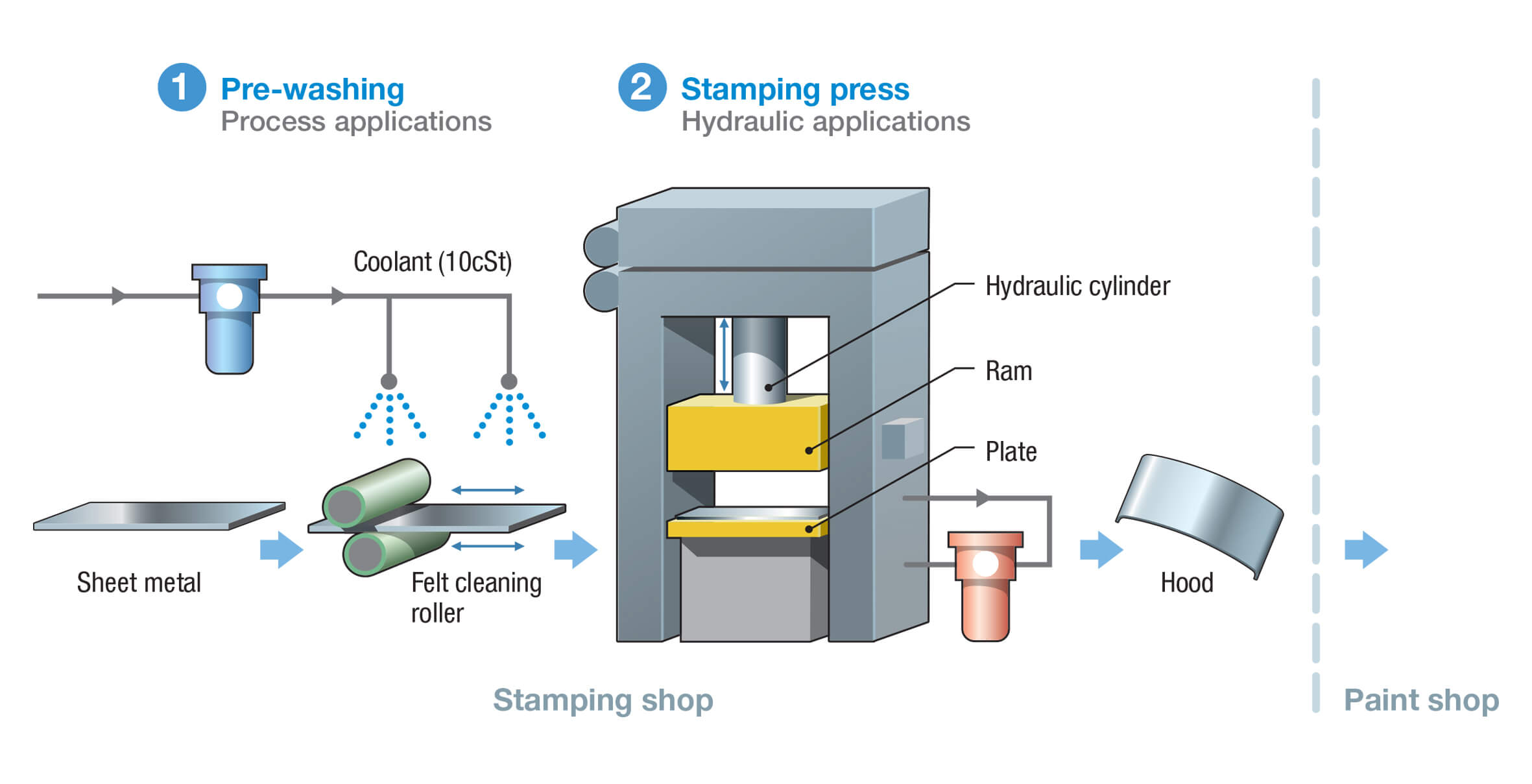Prensa de estampagem automotiva para o sucesso
As prensas de máquinas de estampagem automotiva são uma das peças de equipamento mais comumente usadas na fabricação automotiva. Em uma fábrica de montagem, as prensas de estampagem transformam chapas metálicas em geometrias de peças complicadas, como capotas, para-lamas ou painéis de portas. As prensas de estampagem são geralmente caracterizadas por aplicações de filtro hidráulico e de processo, impactando na confiabilidade da prensa e a qualidade da peça estampada/acabamento da superfície, respectivamente.
Do ponto de vista da produção, a estampagem é uma etapa crítica antes do revestimento eletrônico e da pintura. Antes da estampagem, a chapa geralmente é pré-lavada com rolos de limpeza de feltro para remover quaisquer contaminantes sólidos de sua superfície (metal, sílica, fibras). Quando as partículas que permanecem na chapa metálica são submetidas a uma carga de várias toneladas, elas criam 'marcas' na superfície estampada. Essas marcas geralmente geram defeitos de qualidade ao longo das fases de pré-tratamento, e-coat ou pintura. A prensa de estampagem submete os filtros a duras condições de trabalho, como variações cíclicas de vazão e pressão.
Soluções para maximização da produção, confiabilidade e qualidade
1. Pré-lavagem
Filtração de profundidade para processo de estampagem exibindo uma eficiência de filtração Beta > 5.000 combinada com longa vida útil. Este filtro garante a limpeza do líquido de refrigeração e evita o entupimento dos bicos do sistema de lavagem a baixa pressão. A pré-lavagem é essencial, pois ajuda a evitar 'marcas' na chapa de metal – a pressão aplicada pela prensa sobre o metal pode ser de alguns milhares de toneladas
Produtos adequados:
Elementos de filtro de linha de retorno Athalon™
Elementos de filtro Profile® Coreless
SUPRDisc
Por que não assistir nosso webinar sobre lavagem de peças?
2. Estampagem
Athalon filtros on-line e off-line garantem que a contaminação por partículas resultante de mecanismos de desgaste seja mantida sob controle mesmo nas condições operacionais mais severas. Normalmente, em equipamentos tão críticos, existem muitos componentes muito sensíveis a partículas > 15µm, como servoválvulas ou bombas de deslocamento variável. Filtros resistentes a tensão Athalon garantem que o nível de limpeza do fluido esteja totalmente sob controle para maximizar o tempo de atividade do equipamento enquanto protege os componentes hidráulicos críticos.
3. Remoção de Verniz e Água
Removendo esses elementos do fluido hidráulico, os módulos de filtro SUPRAdisc™ e Purifiers fornecem o melhor resultado. Esses dois itens trabalhando off-line são incrivelmente eficientes na remoção de verniz e água. Os módulos de filtro lenticular SUPRAdisc são feitos de um meio à base de fibra de celulose, combinado com resinas e aditivos, enquanto os purificadores contam com a tecnologia de “transferência de massa sob vácuo”.
A tecnologia de filtração de estampagem de autos da Pall aplicada às aplicações de hidráulica e processo permite que as montadoras de automóveis e fornecedores Tier 1 maximizem a produção que sai da oficina de estampagem:
- Aumente a confiabilidade e o tempo de operação dos equipamentos
- Reduza os custos de manutenção
- Reduza as taxas de defeitos/retrabalho na oficina de pintura
As soluções Pall Filtration para prensas de estampagem automotiva melhoram a eficiência e a segurança do processo de estampagem. Para obter mais informações, entre em contato com um especialista da Pall hoje mesmo.
Para saber mais sobre como melhorar a eficiência de seus processos, contate nossa equipe de especialistas em filtração.
Nossos produtos
Liderando o setor com soluções de produtos que atendem às necessidades dos seus clientes.

Pré-tratamento e e-coat


